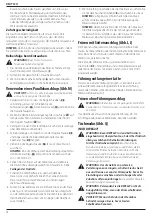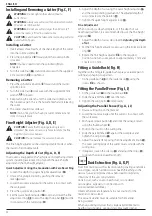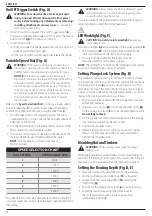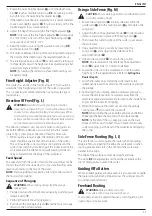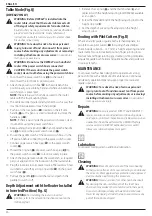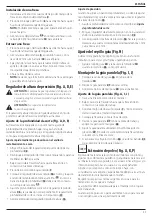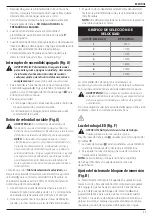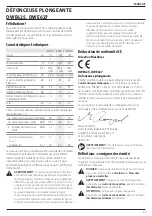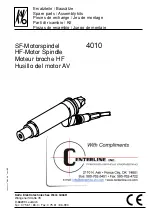
36
EngLIsH
D
Cleaning
WARNING:
Blow dirt and dust out of the main housing
with dry air as often as dirt is seen collecting in and around
the air vents. Wear approved eye protection and approved
dust mask when performing this procedure.
WARNING:
Never use solvents or other harsh chemicals
for cleaning the non-metallic parts of the tool. These
chemicals may weaken the materials used in these parts.
Use a cloth dampened only with water and mild soap.
Never let any liquid get inside the tool; never immerse any
part of the tool into a liquid.
C
Lubrication
Your power tool requires no additional lubrication.
Repairs
WARNING:
To assure product SAFETY and RELIABILITY,
repairs, maintenance and adjustment (including power
cord repairs, and brush inspection and replacement, when
applicable) should be performed by a
D
e
WALT
factory
service center or a
D
e
WALT
authorized service center.
Always use identical replacement parts.
MAINTENANCE
Your power tool has been designed to operate over a long
period of time with a minimum of maintenance. Continuous
satisfactory operation depends upon proper tool care and
regular cleaning.
WARNING:
To reduce the risk of serious personal
injury, turn tool off and disconnect tool from power
source before making any adjustments or removing/
installing attachments or accessories.
An accidental
start-up can cause injury.
Routing with Pilot Cutters (Fig. R)
Where a parallel guide or guide bush are inappropriate, it is
possible to use pilot cutters
50
for cutting shaped edges.
These include collets (6 – 12.7 mm), a height adjusting tool and
router table for use in inverted position, finger jointing tools
for dovetail and finger jointing jigs, dovetail jointing templates,
adjustable guide bush holder and guide bushes and guide rails
in various lengths.
1. Remove the cap nut
51
and the thumb wheel
4
and
replace it with the height adjusting tool (DE6966) available
as an option.
2. Screw the threaded end of the height adjusting tool to the
height stop rod
5
.
3. Set the depth of cut using the adjuster on the height
adjusting tool.
Depth Adjustment with the Router Installed
in Inverted Position (Fig. G)
WARNING:
For installing the router in inverted
position, refer to the relevant instruction manual on the
stationary tool.
Table Mode (Fig. Q)
(DWE627 ONLY)
WARNING: Before DWE627 is installed into the
router table, check that the router table meets all
of the legal safety requirements for router tables.
Read all safety warnings, instructions, and specifications
provided with the router table. Failure to follow all
instructions and safety rules may result in electric shock,
fire and/or serious injury.
WARNING: To reduce the risk of serious personal
injury, turn unit off and disconnect it from power
source before making any adjustments or removing/
installing attachments or accessories.
An accidental
start-up can cause injury.
WARNING: Do not use the DWE627 as a handheld
router if the power switch box is connected.
CAUTION: If there is dust inside the power switch
socket, clean it out before using the power switch box.
1. To connect the power switch box
42
to the router,
disconnect the tool from its power source.
2. Attach the power switch box
42
to the workbench in a
position easily accessible by hand and where unintentional
switching on is prevented.
nOtE:
The external switch can be secured to the router
table with the four mounting holes.
3. The cable must be installed and fastened in such a way that
it cannot be squeezed or touch sharp edges.
4. Push in on the lock button
43
located on the left side
handle
44
with a pen or a small screwdriver to unlock the
handle cap
45
.
nOtE:
If there is dust inside the power switch socket, clean
it out before using the power switch box.
5. Keep pushing the lock button
43
in and rotate the handle
cap
45
to access the power switch socket
46
.
6. Ensure the paddle switch of the power switch box is in the
off position before connecting to the power switch socket.
7. Connect power switch box plug
47
to the power switch
socket
46
.
8. Thread the ring nut
48
of power switch box plug
47
to
the power switch socket
46
to lock it securely in place.
9. Attach the plunge router under the workbench, as required
per your application or the instruction for the router table.
10. Plug the tool back into its power source. The router can now
switched on and off by acting on paddle
49
on the power
switch box
42
.
11. Pull out the paddle
49
to start the tool and push in the
paddle to switch it off.



